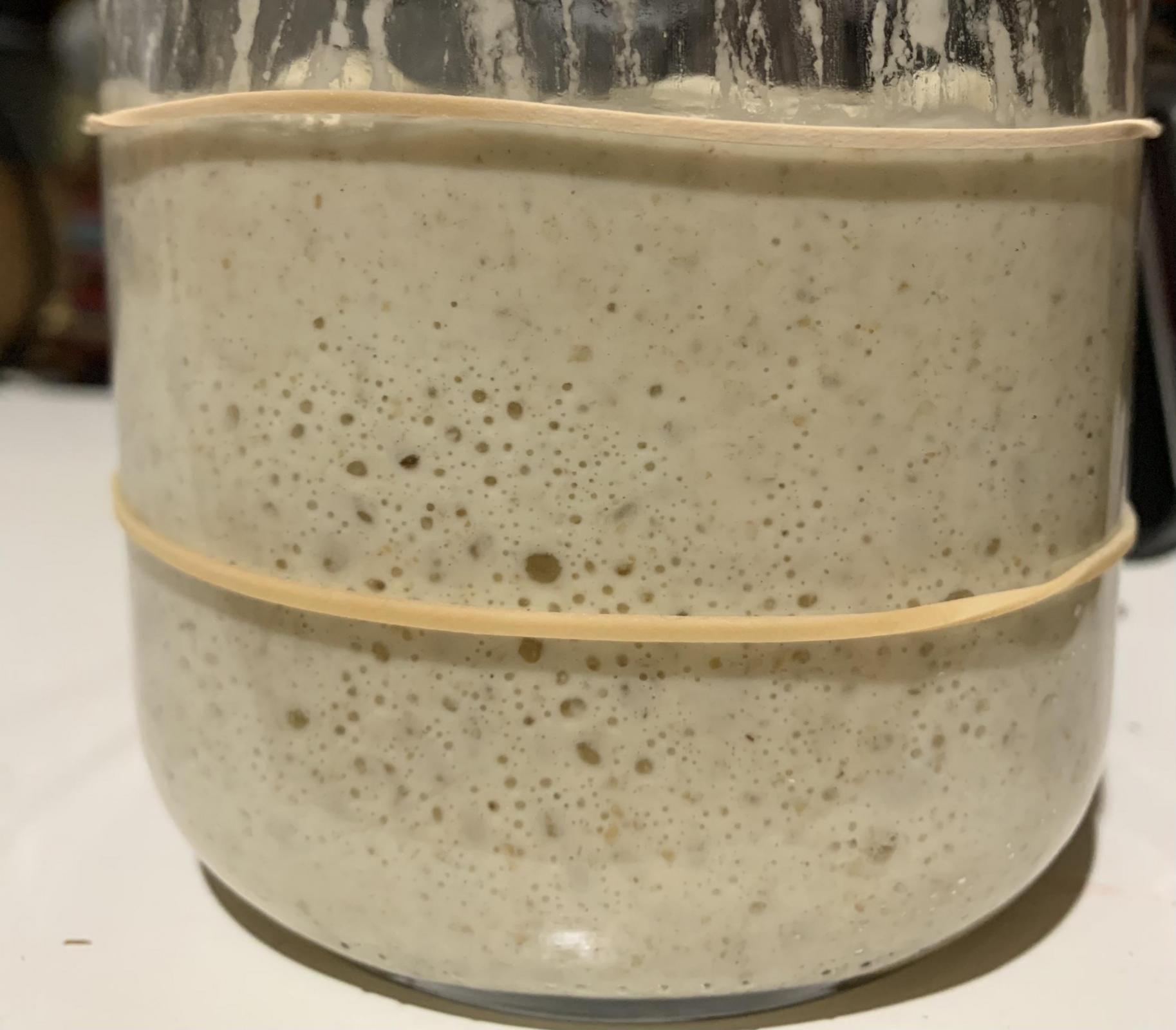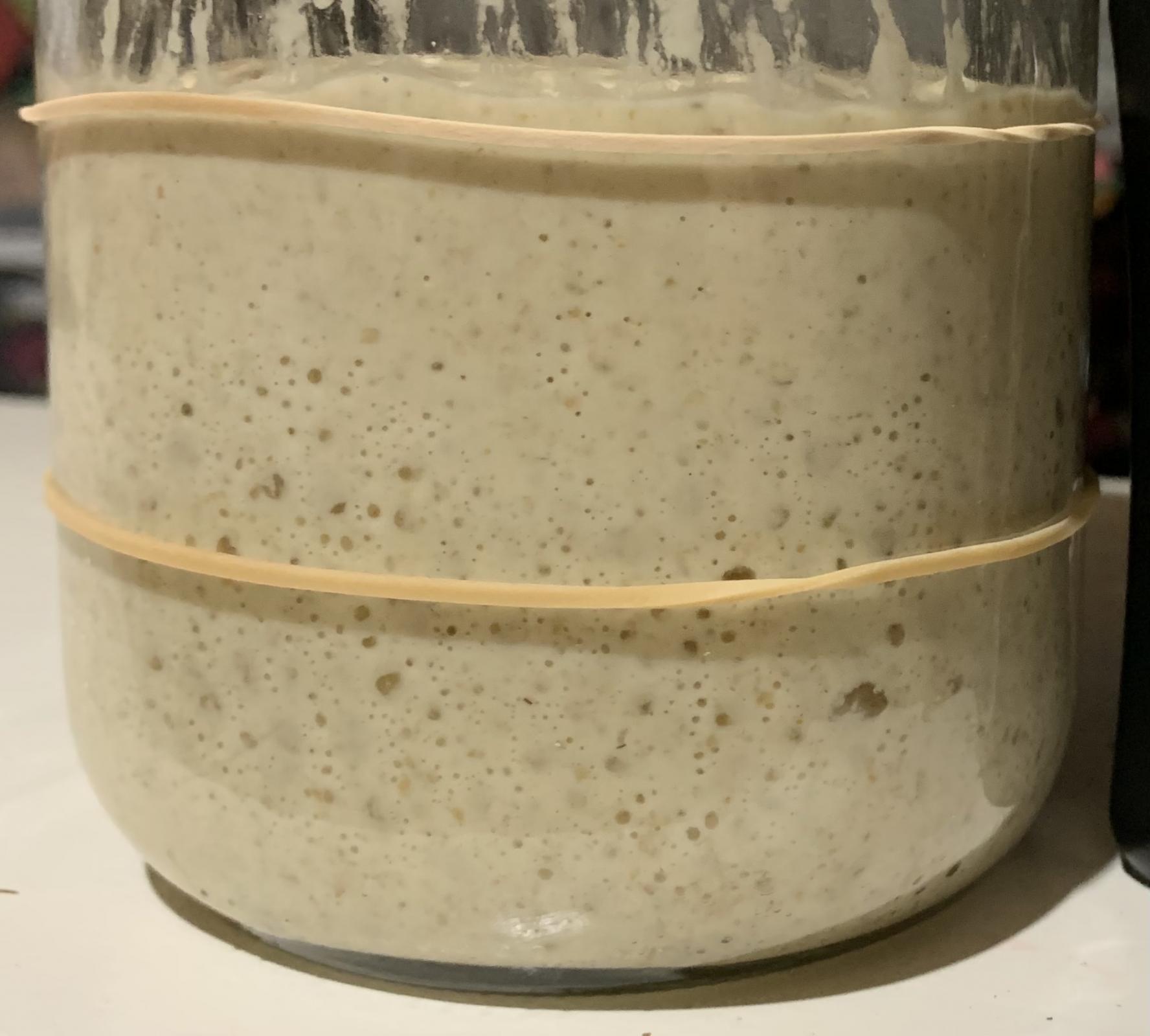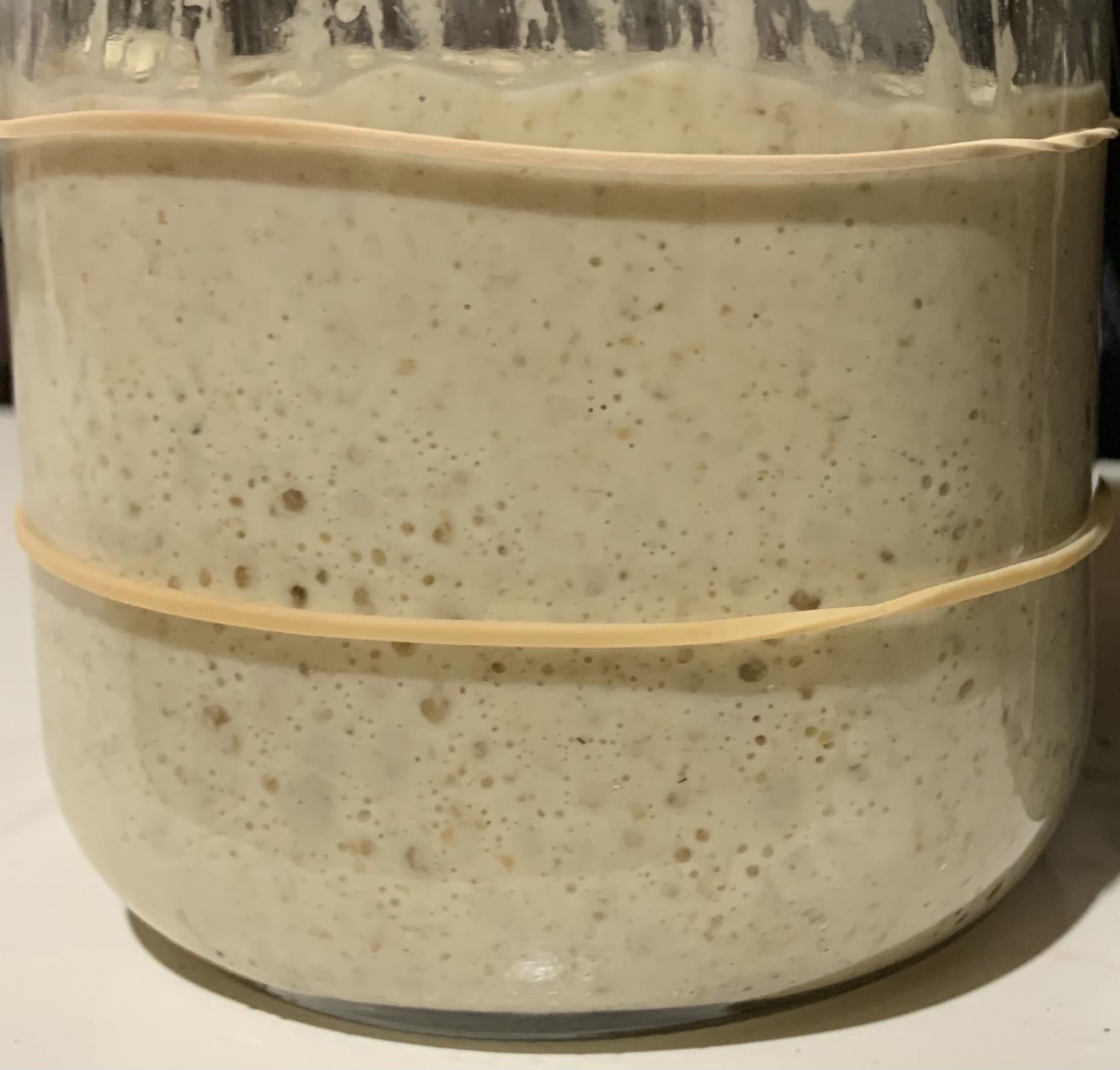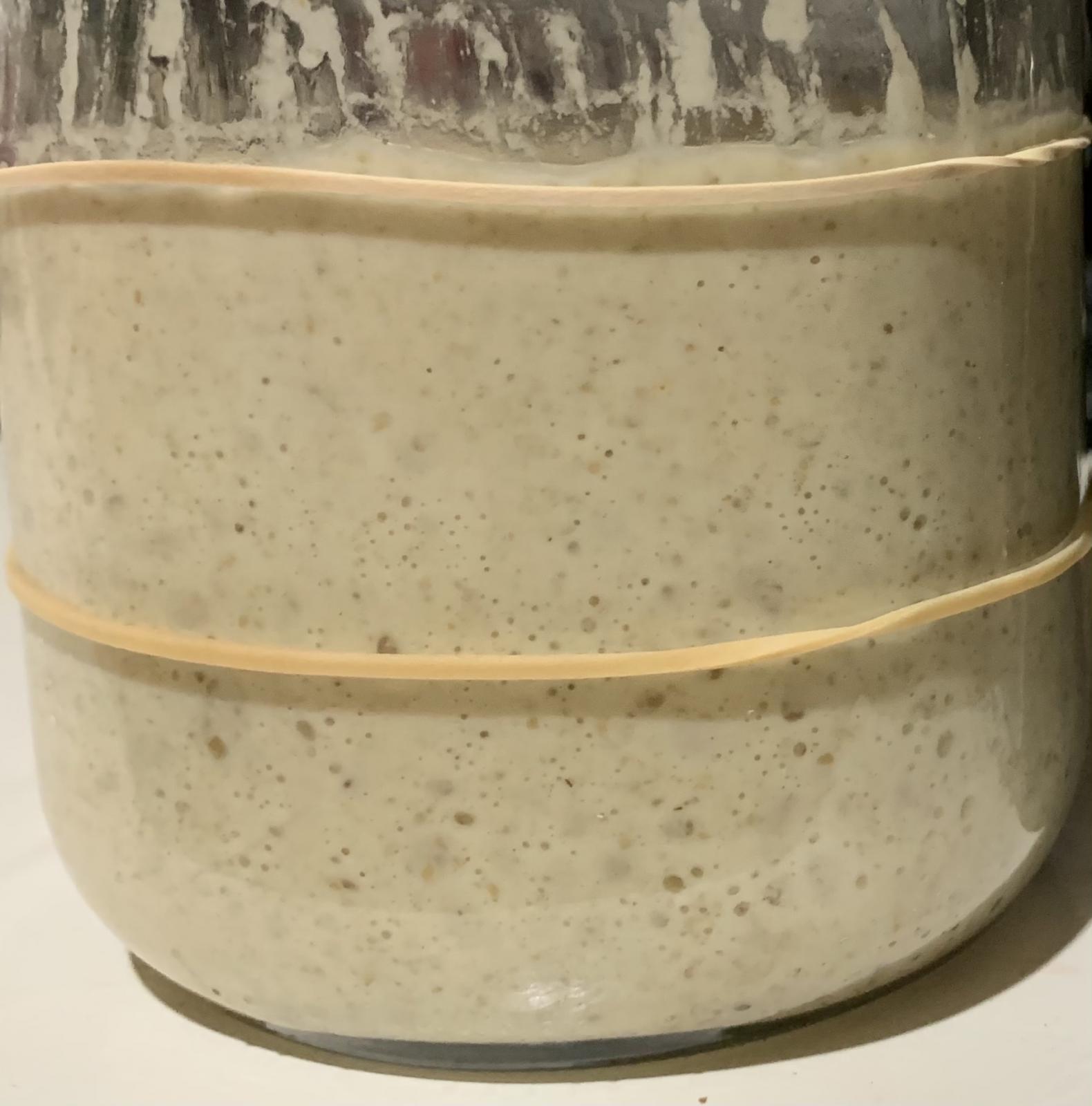I've tried this recipe numerous times, and I'm quickly approaching the definition of insanity: I keep expecting a different result, but no matter what I try, I have very long bulk ferments. Made 10% of the levain flour whole rye this time to try and give it a little extra oomph. Bake details here.
I build the levain per the method (1:5 ratio on starter to flour). It calls for 12-16 hours at 70 deg. It's about 73 deg in my basement. This morning when I got up (8 hours into the build), my levain was already at least doubled. It continued to rise a very small amount until the 9.5 hour mark. At 10 hours, it was starting to recede, so I moved to mixing.
So, if my whole rye starter can make a levain over double in 8 hours at 1:5 and 73 deg, I can't for the life of me understand why it takes almost 12 hours for the dough to double when I have a 1:1.7 ratio in the final mix and BF at 76 deg. The method calls for 2-2.5 hours BF and 2-2.5 hours final proof (both at 76 deg).
I took pictures of the levain this morning at each stage. Am I waiting too long to go to final mix? Should I have started at 8 or 9 hours?
The bread turns out good, so I'm not complaining about that. It's just not working when you make plans for the day and expect to have the bake done mid - late afternoon, and then you're still waiting for it to rise well after dinner.
8 hours

9 hours

9.5 hours

10 hours

When I check my starter for readiness, before I mix the final dough for Vermont sourdough, I verify that it can double in one hour or less at prescribed temperature. If not, I let it mature longer, for yeast to continue to multiply.
Hamelman gives us 12 to 16 hour for starter to mature if fed 1:12 and kept at 20-22C. In my case it's 15g starter (6g flour+9g water), 75g all purpose flour, 94 g ice cold water. 6:75 is feeding 1:12 or so. Feeding ratio is prefermented flour to fresh flour, water is irrelevant. Hamelman's starter is pure white flour, no rye.
For example, my starter for that bread quadruples in volume in 15hrs and recedes a bit. Then I punch it down and it more than doubles again in one hour. This satisfies my requirement. The starter is active and has enough yeast cells in it, it will leaven bread dough. Then I mix bread dough and it doubles in 2 hrs, despite punching it down by stretching it and folding it, next comes shaping and 2 hrs proof and bake.
Thank you for the comments and insight!
My starter maintenance is close but a little less than that... 1:10.5.
If I understand your method correctly, would you have taken the starter when it was at 10 hours (just started receding) and stirred it down and let it double again?
It's not so much starter maintenance as part of the recipe. We could call it Hamelman's levain. My starter maintenance is very different from what Hamelman does in that bread.
Anyways, bakers have certain universal requirements towards gassing power of yeast in their starter or else production schedule would become impossible. A mature starter doubles or triples rather quickly. When they publish their recipes, they assume that readers have the same starter doubling time.
So yes, test your starter for readiness. Initially, as you feed it, it simply multiplies its numbers of yeast and bacteria cells, so how long it would rise to peak is not that important. Punch it down and see how long it would take to double. If longer than one hour, let it stand, until its top flattens and begins to recede and punch it down again, to test for doneness. If it doesn't double again, but peaks at lower height, then reinforce your flour.
Otherwise, if you add too little yeast to your loaf, it takes forever to rise and accumulate flavor, because you have to wait for yeast to multiply inside bread dough first and only then ferment its flour.
This is the connection I was missing!
Anyways, bakers have certain universal requirements towards gassing power of yeast in their starter or else production schedule would become impossible. A mature starter doubles or triples rather quickly. When they publish their recipes, they assume that readers have the same starter doubling time.
Thank you much! Will see what I can do to tweak a few things for the next attempt. I don't need to get all the way down to 5 hours total fermentation, but less than 11-12 would be good. :-)
Hi, Mariana,
I'd like to know if I can use your technique to measure an enriched bread pre-dough's leavening power.
The bread I have in mind uses butter and eggs at 16% each, 20% sugar, plus milk (% TBD).
I plan to pre-ferment 100% of the flour using 2% active dry yeast, all the butter and eggs, and some milk at ~ 30C/86F. I also plan to boost the final dough with more dry yeast to counter sugar's impact on slowing down the fermentation once it's added to the dough.
I hope to optimize the pre-dough's leavening power, and with the aid of additional dry yeast, shorten the fermentation time as much as possible.
First of all, is your technique applicable to dough made with commercial yeast? If so, do I wait until the pre-dough stops rising and starts to recede before punching it down?
I also wonder, when a dough doubles in volume, what does it indicate? Why so many bread recipes use this phenomenon to mark the end of bulk fermentation? A dough's yeast may not be at its best or strongest at this point, but it probably does not matter if we are working with a lean dough. An enriched dough may be a different story.
I greatly appreciate any advice from you. Thank you as always.


Yippee
Hi Yippee,
yeast baking is very different, because you already know the leavening power of yeast, it is guaranteed by the manufacturer and you can vary the amount of yeast at will as well. So, yeasted preferments have a different purpose: to modify flour (to weaken it or to strengthen it) and to accumulate flavor.
Any dough or preferment should be punched down as it begins to flatten on top or to sag in order to protect its gluten. You would let it rise again and again if its acidity and flavor are not there yet. Again, it has nothing to do with the leavening power, because the gassing power of commercial yeast is a given, guaranteed by the manufacturer. And commercial yeast cells never multiply in bread dough or in preferments, because the amounts added by the baker are too large. Commercial yeast would multiply in dough only if added in super-tiny amounts.
I can't speak for the bakers who only let their dough double. I have no idea why they do it. It is never done in commercial baking. In baking books they would write about doubling, for example "let rise at room temperature until doubled in bulk, about 1.5 hours", but they don't really mean it in mathematical sense, because there is a ball of dough in a bowl and there is no strict measuring of volume per se. It might double in height or in diameter, but that doesn't mean doubling in volume, of course. Basically, doubling means 'rising' or 'becoming puffy'.
The true end of bulk fermentation is marked by a different method. The dough is ready when it accumulated enough flavor and acidity. Usually, fermentation at certain temperature for so many hours or minutes will give you that, provided your flour has indicated ash content and your yeast is the same type of yeast as in the recipe. With experience, you just know that your dough (or pre-dough) is ready, the bulk fermentation is over, because it smells just right.
Don't use ADY for your enriched dough, please. It is not suitable for the levels of sugar higher than 8-10%. Use SAF osmotolerant (preferably) or at least SAF instant yeast, or any other brand instant yeast, not ADY. Even 2% of ADY which is equivalent to 4% of compressed yeast, is such a huge amount, it will introduce an excessive amount of glutathione with it, because ADY has a lot of dead yeast cells in it.
I cannot comment on your chosen method of making an enriched dough, I have not tested it and I am unfamiliar with that bread.
Basically, you give me a formula of 100 flour, 2-3% dry yeast, 20% sugar, 16% butter and 16% eggs, milk and (possibly) water.
I can share with you how I make something similar, sweet Vienna bread: 100 flour, 5% compressed yeast (1.8% instant), 1% salt, 26% sugar, 15% butter, 13% eggs, 15% whole milk (4% milk fat), vanilla, water as needed to adjust dough consistency.
Amounts for 500g of flour (25g used for sprinkling the work surface), 2lbs of baked bread.
Sponge: 300g all-purpose flour, 7g instant yeast, 90g sour whey or water, 75g whole milk or buttermilk. Mix, let rest for 30 min, then mix again and let it ferment for 2.5-3 hrs at 20-22C (68-72F). Punch it down each time it rises to the max and its top surface is covered with holes (when gas begins to escape from the dough).
Dough: 150g all-purpose flour, 2g instant yeast, 5g salt, 30g sugar, 25g butter, 65g eggs or egg and egg yolk blend, 30g water. Mix on low or medium speed for 10-12 min. Let it rest for 30 min, mix until smooth. Let it rise until at least 3x or 4x in volume, approximately 1 hr at 20-25C (68-77F)
Enrichment: 25g all-purpose flour, 100g sugar, 50 g butter, vanilla or a packet of vanillin. Add to dough and mix for 10-15 min on low or medium speed. Let it ferment until at least doubles in size, for 1.5-2 hrs at 20-25C (68-77F). Knead thoroughly do deflate completely: in my Bosch mixer it takes about 10 min on 1-2 speed.
Refrigerate for 15 min, divide, bench rest for 10 min, shape. Proof for 1hr 30min at 35C (95F). Egg wash, give another 10-20 min of proof, egg wash again and bake/
If you want to shorten the fermentation time, use sour whey as part of your formula (drain it from yogurt), or a bit of sourdough or water from washing sourdough. Adding too much yeast will make young puffy dough. It will be 'big', it will rise tall, but will taste like sugary water, 'empty' of flavor.
Good luck!
m.
I have measured my dough volumes accurately at all stages in the past, using Archimedean displacement.
The volume increase after BF and proving is a lot less than I expected and the spring is a lot more than I expected.
i also learned that the volume of a risen boule approximates pretty accurately to a ellipsoid minus an ellipsoid cap, which can be easily calculated from the boule height and diameter alone. Within 3% accuracy.
When I insist on over-sharing something like this ellipsoidal “discovery” at home, my two children are inclined to reprise a popular cartoon called The Knack.
My Daugter (in the role of young Dilbert’s Mum): “Will he lead a normal life?”
My son (cast as the Doctor): “No, he’ll be an Engineer”
Can’t think why ...
A man after my own heart! I have success gauging bulk with the "dipstick method" - measuring down from the rim of the container to the dough surface with an old Moore & Wright depth gauge and converting it to a volume from a calibration table.
Lance
Thank you Mariana.
Search for a post by a "the first Ashley" for more details on the method of starter maintenance (and a little about creation). I think it was like last summer or fall and i went into the concept in more detail. Kinda good to see it getting used as it really is the only way to really determine starter strength. Enjoy!
Troy, I don’t have Hamelman’s book so don’t have the Vermont SD recipe to refer to, however, if his levain one of the levains that are higher than 100% hydration? For these levains which have a more watery consistency, they won’t retain as much of the gas that they produce and may start to fall a bit before they are fully matured. In this case, I would follow Hamelman’s instructions and give the levain more time to fully mature before use. Levains that are 100% hydration or less, will hold more of the gases and are in my experience easier to read by their peaking and falling on when to use.
Benny, it does call for 125% hydration, but I dropped it to 110% for the reason you mentioned above. Next time, maybe I'll just let it go 13-14 hours. Not sure how much the 73 deg vs 70 deg levain build temp impacts that time. Will have to dig into that some as well. My basement is a pretty constant 72-73 deg all year, so it should be reproducible once I get it right.
In the end, the loaf turned out really nice, so can't complain overall. :-)
Yes I just saw your crumb post in the other thread and I agree that is a superb crumb especially if you want to put spreads on it. Well done.
Along with the doubling times of your starter how is its strength? By that I mean is it soupy and pourable or does it hold together and have some stretch and elastic qualities. If you watch this video from fullproof baking you will see what I mean. Activating your starter
I don't know why these qualities are indicative of strength but I know that they produce a stronger dough with more lift and volume.
I never quite understood this recipe, although I've made it. The bulk time is specifically stated as 2 1/2 hours at DDT 76F.
Many bakers work more to a specific volume increase, possibly using an aliquot jar. When I made it, I thought 2 1/2 hours seemed rather short, but I went with the recipe.
For those with more experience of the recipe, what do the 2 1/2 hours bulk equate to in volume increase terms?
Lance
I agree with you Lance, I do like to know what degree of rise we are aiming for, I don’t like recipes that rely only on time and temperature, that assumes equal strength of starters. If your recipe describes rise, you can deal with your temperature and starter and still know what to aim for.
Lance,
with this recipe there are two considerations and both have to do with mass effect. This is a recipe for a bakery. No one watches volume increase in a bakery. Also, this dough is degassed several times during bulk fermentation (2-3 s&fs), so its volume increase loses meaning altogether.
The fermentation time is given for a large batch of dough. 2.5hrs or 150 min is for a large batch. For a smaller batch we would ferment it for 20% longer, or for 180min.
In a large batch of dough there is another mass effect, its temperature rises on average 1.1C (about 2F) per each hour of fermentation. So, even if DDT at the end of mixing is is 76F, at the end of bulk fermentation period that same dough would reach 81F in a bakery. At home we create a warmer environment around our dough to mimic bakery environment and mass effect. We ferment it in a warm place for 3 hrs at 80-81F. And our dough will also end up warm inside by the end of that period.
From my experience, when the final piece of dough is ready to be divided, it is about 1.5-2x size of the initial freshly mixed dough for this bread. Then it at least doubles in size as it proofs and doubles again as it bakes.
For two loaves 1 lb each, I kneaded dough in my bread machine. 25 min of kneading.
This is how puffy it looks after bulk fermentation and 3 s&fs, ready to be divided and shaped
shaping
2hrs proof
bake
Thank you for your explanation, Mariana. I guess as with most recipes, you need to make it a few times to get the best from it.
Nevertheless, if I were to make it again, I would up the hydration to 68% - and that is with English flour, never mind American or Canadian! And I would aim for a 40-60% bulk rise, or maybe a pH of 4.6. But that's just my take....
PS are you also Mariana_aga from Livejournal.com?
Lance
Thank you for the pictures! Always helps me visualize where I’m at in the process. Your picture of the end of BF is where I was at about 6.5-7 hours.
Great looking loaf at the end!